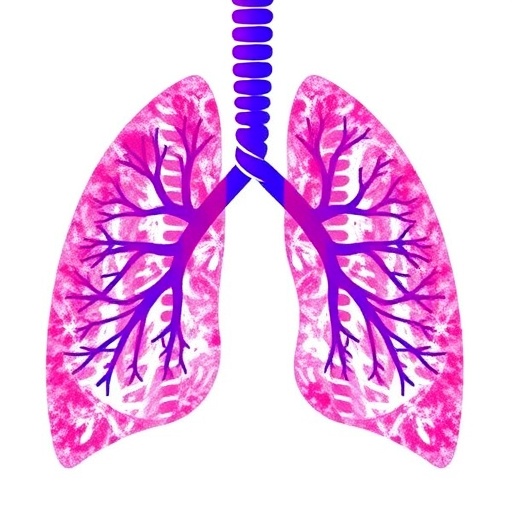A groundbreaking study has emerged from the collaborative efforts of researchers aiming to unravel the intricate molecular underpinnings of lung adenocarcinoma (LUAD), a predominant subtype of non-small cell lung cancer (NSCLC) known for its clinical heterogeneity and poor prognosis. By leveraging an integrative multi-omics approach, this research delineates a sophisticated model that not only advances our understanding of LUAD tumorigenesis but also holds promising clinical implications for early diagnosis and prognostic stratification.
At the core of this investigation lies the utilization of high-throughput sequencing datasets encompassing epigenomic and transcriptomic landscapes. Specifically, ATAC-seq datasets sourced from The Cancer Genome Atlas (TCGA) provided insights into chromatin accessibility alterations driving LUAD progression. Complementing this, RNA-seq data from TCGA and the Genotype-Tissue Expression (GTEx) project facilitated an exhaustive examination of differential gene expression profiles between tumor and normal lung tissues. The integration of these datasets stands as a testament to the power of multi-omics in dissecting cancer biology beyond singular molecular dimensions.
The research commenced with the identification of differential chromatin regions by comparing early and late-stage LUAD specimens using ATAC-seq data. These differential peaks (DPs) serve as potential regulatory elements modulating gene expression aberrancies contributory to oncogenesis. Annotating these peaks to contiguous genomic loci enabled extraction of differential peak genes (DPGs), laying the groundwork for subsequent molecular characterizations.
In parallel, transcriptomic comparisons entailed rigorous statistical analysis to discern differentially expressed genes (DEGs) implicated at the mRNA level. The cross-referencing of DEGs with DPGs culminated in the recognition of a consensus gene set, totalling 337 genes, that are not only transcriptionally dysregulated but also located within epigenetically remodeled chromatin arenas in LUAD.
To translate this vast gene repository into clinically actionable targets, the investigators employed advanced machine learning algorithms: random forest and Least Absolute Shrinkage and Selection Operator (LASSO) regression models. This computational pipeline distilled the candidate gene pool into nine predictive-related genes (Pre-RGs), forming a robust predictive model with potential for clinical application. Validation of this predictive model using an external dataset (GSE140343) reinforced its generalizability and predictive accuracy.
The prognostic utility of gene signatures was further interrogated through survival analyses. By integrating Kaplan-Meier and Cox proportional hazards models alongside LASSO selection, five prognostic-related genes (Pro-RGs) were extracted. These biomarkers exhibited significant correlations with overall survival metrics in LUAD patients, underscoring their potential to refine prognostic assessments. The prognostic model also underwent stringent validation in independent cohorts, bolstering confidence in its clinical relevance.
A novel dimension of this work pertains to the single-cell RNA sequencing analysis, which mapped the expression patterns of Pre-RGs and Pro-RGs across diverse immune cell subsets within the tumor microenvironment. This single-cell resolution analysis elucidates the intricate interplay between tumor cells and infiltrating immune populations, offering insights into immune evasion mechanisms and potential immunotherapeutic targets.
Further meta-analyses utilizing data from the Lung Cancer Explorer (LCE) database confirmed the differential expression and prognostic value of these genes, thus triangulating evidence from multiple independent datasets. This comprehensive validation strategy enhances the likelihood that these gene signatures will withstand the rigors of clinical translation.
Significantly, the study extended beyond tissue analysis to explore non-invasive biomarker potential. By sequencing cell-free RNAs (cfRNAs) extracted from plasma samples of 50 individuals—including early-stage lung cancer patients and benign pulmonary disease controls—the researchers evaluated the feasibility of utilizing cfRNA profiles for early cancer detection. This approach is particularly compelling for its promise in minimally invasive diagnostics, which could revolutionize lung cancer screening practices.
Among the identified gene signatures, several stand out for their biological and clinical significance. For instance, S100A8, implicated in inflammatory responses, has been linked to tumor progression and metastasis. Other genes such as GPM6A, FEZ1, and OTX1 play roles in cellular signaling and differentiation, potentially contributing to oncogenic pathways. The inclusion of DNAH14, XDH, XPR1, and SLC39A11 highlights the diversity of functional pathways intersecting in tumor development.
OCIAD2, TNS4, RHOV, YWHAZ, CLEC12A, and CASZ1 similarly represent a spectrum of molecular functions including cell adhesion, cytoskeletal dynamics, signal transduction, and transcriptional regulation. Their combined signature not only predicts LUAD progression but also flags targets amenable to pharmacological intervention, opening avenues for personalized medicine.
This multi-layered analytical strategy, integrating epigenomic remodeling, transcriptional profiling, and plasma biomarker exploration, sets a new benchmark in lung cancer research. The convergence of interdisciplinary datasets underscores the transformative potential of systems biology to address the formidable challenges posed by cancer heterogeneity.
Importantly, the study’s methodological rigor, characterized by external validations and meta-analytic confirmations, adds robustness seldom achieved in biomarker discovery studies. These findings portend a future where lung adenocarcinoma patient management could be radically improved through precision diagnostics, informed prognostics, and targeted therapeutics.
With lung adenocarcinoma remaining a leading cause of cancer mortality worldwide, breakthroughs such as this are critical to reducing disease burden. The identification of multi-omics-derived gene signatures equipped with predictive, prognostic, and early detection capabilities heralds a paradigm shift toward more effective surveillance and individualized care strategies.
While challenges remain in translating these molecular insights into routine clinical practice, including validation in larger prospective cohorts and functional characterization of candidate genes, the current findings provide a robust foundation for subsequent translational research.
This study exemplifies the power of integrating diverse omics data, machine learning, and clinical informatics to illuminate the complex biology of cancer. It inspires optimism that such comprehensive models will catalyze the development of non-invasive diagnostic tools and personalized treatment modalities capable of improving patient outcomes in lung adenocarcinoma.
As multi-omics technologies continue to evolve and become more accessible, their application in oncology research promises to accelerate the discovery of novel biomarkers and therapeutic targets, bridging the gap between molecular research and clinical implementation.
In conclusion, the identification of key tumorigenesis- and prognosis-associated genes with clinical potential in LUAD represents a significant stride forward. These advances underscore the importance of systems-level approaches in cancer biology and open promising new avenues for early detection and prognostic evaluation, ultimately aiming to reduce mortality and enhance quality of life for lung cancer patients worldwide.
Subject of Research: Multi-omics data integration for tumorigenesis, prognosis, and early detection biomarkers in lung adenocarcinoma.
Article Title: Multi-omics data-based modeling reveals tumorigenesis- and prognosis-associated genes with clinical potential in lung adenocarcinoma.
Article References:
Lu, Z., Bao, P., Wang, T. et al. Multi-omics data-based modeling reveals tumorigenesis- and prognosis-associated genes with clinical potential in lung adenocarcinoma.
BMC Cancer 25, 1743 (2025). https://doi.org/10.1186/s12885-025-14943-x
Image Credits: Scienmag.com
DOI: 10 November 2025
Tags: cancer genomics and epigenomicschromatin accessibility in LUADdifferential gene expression in lung tumorsearly diagnosis of lung cancerhigh-throughput sequencing in cancer researchinsights from ATAC-seq datasetslung adenocarcinoma researchmulti-omics approach in lung cancerprognostic stratification in oncologyregulatory elements in oncogenesisRNA-seq analysis in cancertumorigenesis in non-small cell lung cancer





